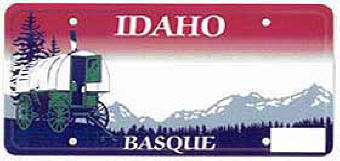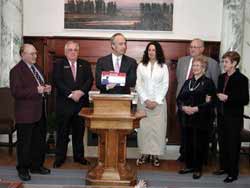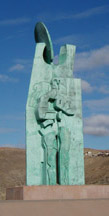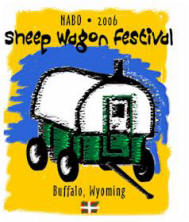|
|
|
|||||||||||||
| A1.4 BASQUE LICENSE PLATE | |||||||||||||
|
|
|||||||||||||
| Originally published April 5, 2006 by John M. Ysursa. Neither NABO or the Basque Government is responsible for the following content. | |||||||||||||
|
While these sheep wagons are few nowadays, for a time in the 20th century they were omnipresent as people traveled through the state. At that time, the wagons served as mobile homes for the many Basque sheepherders. It is fitting in a sense that the new plates use this symbol to pay tribute to the Basque-American heritage, because in Idaho as in most western states, it was the sheep business that served as the real beginning of most our communities.
Basques have been in the Americas for centuries--most probably even before the arrival of Columbus. Most of the current Basque communities of the American West, however, trace their origins to the more recent past. of the Basque sheepherding story of the American West goes to the California Gold Rush that brought a sustained number of Basques to the American West. Most "49ers" did not find their gold and had to turn to an alternative plan, and thus some Basques went into ranching. By the 1870s Basque sheep outfits had expanded throughout the high desert country of the American West. Anyone who has driven the high desert ranges of the West has pondered how someone could possibly live there. It's possible, but the life was very demanding, compounded by the reality that sheepherding as an occupation was not favorably looked upon. Basques took the job because it offered them economic opportunity. These hundreds of herders tended bands of sheep for months on end in a harsh, desolate environment. They were usually all alone. It was not an easy existence, but thanks to their perseverance their descendants were able to enjoy a better life here in America.
Ironically these Basque newcomers knew little or nothing about herding sheep; they literally learned on the job. They did so well that they quickly became sought after by sheep outfits while some Basques moved into positions of ownership that together initiated the practice of bringing over other Basque young men. Many obtained U.S. citizenship, and trips to the Basque homeland now became vacations often with the primary purpose of finding a Basque wife.
While shepherding served as the foundation of the Basque community for many years, today few Basques remain active in the sheep industry. By the 1970s the Basque involvement in the sheep business began its decline. Various factors contributed to this transformation, beginning of course with the immense challenges posed by the occupation that thrust the herder into "one of the loneliest professions in the world." A domestic struggle over the use of public land which resulted in the limitation of livestock grazing permits, improved economic conditions in the Basque homeland, recruiting efforts shifting to Latin America and changes in the livestock industry that favored cattle to sheep ranching effectively brought an end to a 150 year story.
But sheepherding was always just a means not an end for most Basques. Thus the children and grandchildren of the herders have diversified into many careers. As William Douglass noted, "the work ethic, business integrity and success of Basques in a wide variety of walks of life resulted in their being viewed in the region as one of its unique cultural and economic assets." One of those Basque sheep men, Pete Cenarrusa, made his way into Idaho politics and went on to serve as both a lawmaker and then Secretary of State. Upon his retirement from office, he turned his energies into the newly founded Cenarrusa Center for Basque Studies, the sponsoring organization of this special plates.
The sheepherding legacy has left its mark on the Basque-American community. Many of our communities remain clustered around former centers of the sheep industry (e..g, Boise, Elko, Bakersfield, etc.) and almost every Basque picnic is defined by a lamb meal. This summer's 2006 NABO Convention hosted by the Big Horn Basque Club of Buffalo, Wyoming (yes, sheep country) has taken the sheep wagon has its festival theme.
The initial cost for the plate is $35. That price drops to $25 when the plate is renewed. These fees are in addition to annual vehicle registration, county and plate fees. The Cenarrusa Center for Basque Studies will receive $25 for each new plate and $15 from annual renewals. These proceeds will go to "preserve the Basque culture, language and contributions to Idaho through educational and outreach programs,” said Pete Cenarrusa. Steve Achabal, President of the Basque Center added, “Purchasing the plate is a great way to show Basque pride and contribute to its preservation.” Patty Miller, Executive Director of the Basque Museum & Cultural Center added that "The Cenarrusa Center's efforts in the area of education will benefit our whole state." Sample versions of the Basque plates can also be purchased.
See also:
|
|||||||||||||
|
This is produced by John M. Ysursa,
NABO's Sustatzailea/Facilitator. Neither NABO or the Basque
Government is responsible for the content. For more information,
and/or to get on our weekly email list by sending your name & email
address, contact us at: info@basques.us |


 he nature of personalized or "vanity" car
license plates have allowed the option for some to make a statement with
their plates. Some have chosen to personalize their plates with a
Basque reference. Some examples of this can be seen at
he nature of personalized or "vanity" car
license plates have allowed the option for some to make a statement with
their plates. Some have chosen to personalize their plates with a
Basque reference. Some examples of this can be seen at






